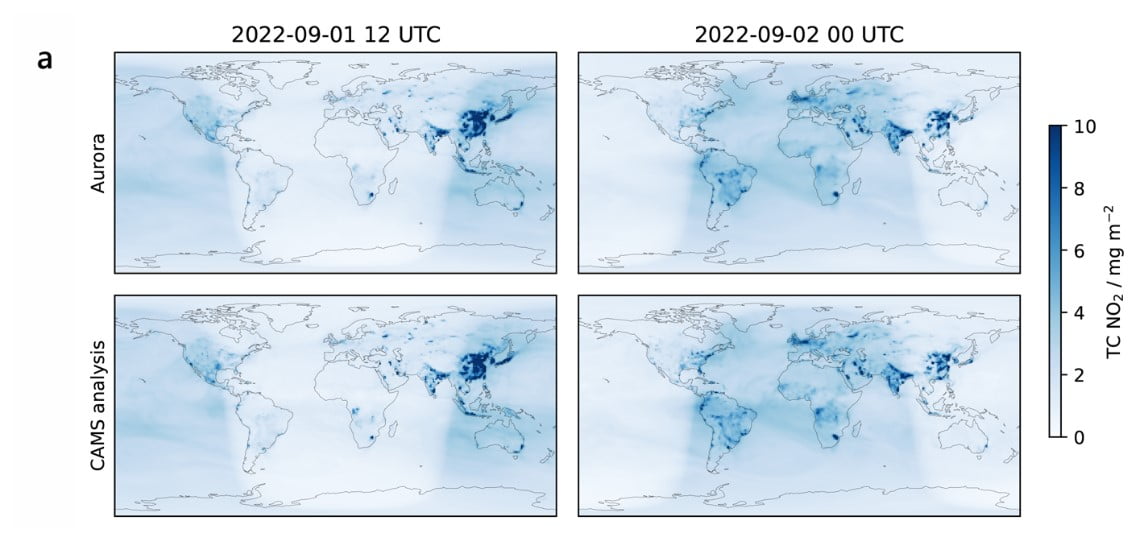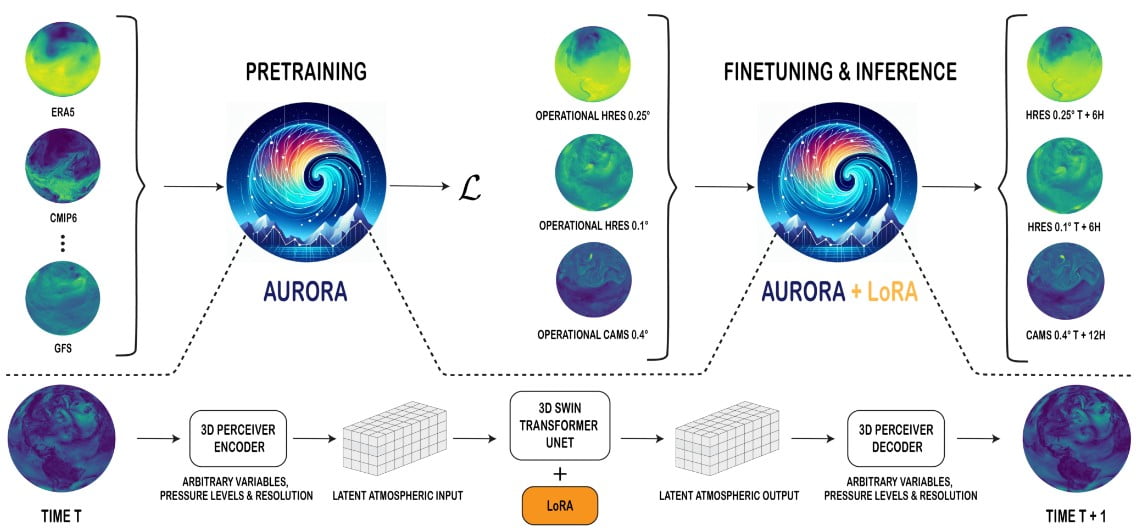Last Updated on June 6, 2024 11:37 am by Laszlo Szabo / NowadAIs | Published on June 6, 2024 by Laszlo Szabo / NowadAIs
Microsoft’s Aurora AI Weather Forecast: AI Will Tell You What The Weather Will Be – Key Notes
- Microsoft’s Aurora AI Weather Forecast: New AI model for accurate and reliable weather predictions.
- High Spatial Resolution: Captures atmospheric details with 0.1° precision.
- Versatile Capabilities: Predicts temperature, wind speed, air pollution, and more.
- Adaptability: Handles diverse data inputs and produces forecasts at varying resolutions.
- Air Pollution Forecasting: Outperforms existing models using data from CAMS.
- Computational Efficiency: Offers a 5000x speed-up compared to traditional systems.
- Global Impact: Democratizes access to accurate forecasts, particularly in data-sparse regions.
- Climate Change Mitigation: Enhances decision-making for agriculture, transportation, and disaster preparedness.
Introduction
In the face of increasingly unpredictable and extreme weather events, the need for accurate and reliable weather forecasting has never been more crucial. As climate change continues to reshape global weather patterns, traditional weather prediction models have struggled to keep pace, often falling short in anticipating the rapid intensification and devastating impacts of storms like the one that battered northwestern Europe in 2023.
However, a new AI model developed by researchers at Microsoft may hold the key to transforming the field of weather forecasting. Dubbed “Aurora“, this foundation model is poised to change our ability to predict and mitigate the effects of extreme weather phenomena, offering unprecedented accuracy, efficiency, and versatility.
Harnessing the Power of Atmospheric Data
At the heart of Aurora’s success is its comprehensive understanding of atmospheric dynamics, forged through extensive training on over a million hours of diverse weather and climate simulations. This expansive data corpus has enabled the model to develop a nuanced grasp of the intricate patterns and structures that govern the behavior of the Earth’s atmosphere, equipping it with the ability to excel at a wide range of prediction tasks, even in data-sparse regions or during extreme weather events.
Unparalleled Spatial Resolution
One of Aurora’s standout features is its high spatial resolution of 0.1° (roughly 11 km at the equator), which allows it to capture the intricate details of atmospheric processes with remarkable precision. This level of granularity not only provides more accurate operational forecasts than ever before but also achieves this feat at a fraction of the computational cost of traditional numerical weather prediction systems.
Versatile Forecasting Capabilities
Beyond its impressive accuracy and efficiency, Aurora’s versatility sets it apart from conventional weather models. The model’s flexible architecture, designed with a 3D Swin Transformer and Perceiver-based encoders and decoders, enables it to forecast a diverse range of atmospheric variables, from temperature and wind speed to air pollution levels and greenhouse gas concentrations.
Adaptability and Scalability
Aurora’s adaptability is further enhanced by its ability to handle heterogeneous data inputs and generate predictions at varying resolutions and levels of fidelity. By leveraging pretraining on a vast corpus of diverse data and fine-tuning on specific tasks, the model can effectively capture intricate patterns and structures in the atmosphere, even with limited training data.
Exceptional Air Pollution Forecasting

One of the standout applications of Aurora’s capabilities is its ability to accurately forecast global air pollution levels, a notoriously complex task due to the intricate interplay of atmospheric chemistry, weather patterns, and human activities. By processing and learning from the highly heterogeneous data from the Copernicus Atmosphere Monitoring Service (CAMS), Aurora has demonstrated its remarkable adaptability, producing accurate five-day global air pollution forecasts that outperform state-of-the-art atmospheric chemistry simulations on 74% of all targets.
Tackling Data Sparsity Challenges
The implications of Aurora’s success in air pollution forecasting extend far beyond the immediate benefits to air quality monitoring and public health. The model’s ability to excel even in data-sparse regions holds the potential to democratize access to accurate weather and climate information, particularly in developing countries and polar regions, where traditional forecasting systems have often struggled.
Unlocking New Opportunities
This breakthrough in AI-powered environmental prediction paves the way for the development of comprehensive Earth system models that can encompass the entire spectrum of atmospheric, oceanic, and terrestrial processes. As the field of AI-based weather and climate forecasting continues to evolve, Aurora may serve as a blueprint for future research and development, inspiring the creation of even more powerful foundation models that can tackle the multifaceted challenges posed by climate change.
Outperforming Specialized Deep Learning Models
One of the key findings of the research on Aurora is the great performance advantage it holds over specialized deep learning models, such as GraphCast, which was previously considered the most skillful AI model for weather forecasting at 0.25-degree resolution and lead times up to five days.
Diverse Pretraining and Fine-Tuning
The superior performance of Aurora can be attributed to its robust pretraining on a diverse range of datasets, including climate simulations, reanalysis products, and operational forecasts. This diverse pretraining has enabled the model to develop a more comprehensive and generalizable representation of atmospheric dynamics, allowing it to outperform even the state-of-the-art numerical weather prediction model, the Integrated Forecasting System (IFS), across a wide range of tasks and resolutions.
Computational Efficiency Advantage
In addition to its accuracy gains, Aurora’s computational efficiency is a significant advantage over traditional numerical weather prediction systems. The researchers estimate that Aurora can provide a computational speed-up of approximately 5,000 times compared to the IFS, making it a highly practical and cost-effective solution for operational weather forecasting.
Paving the Way for a Paradigm Shift in Earth System Modeling
The implications of Aurora’s success extend far beyond the realm of atmospheric forecasting, as this research paves the way for a paradigm shift in Earth system modeling. By demonstrating the power of foundation models in the Earth sciences, the development of Aurora opens up new possibilities for the creation of comprehensive models that can encompass the entire Earth system, from the atmosphere to the oceans and terrestrial environments.
Democratizing Access to Accurate Forecasts
One of the most significant potential impacts of Aurora’s capabilities is its ability to democratize access to accurate weather and climate information, particularly in data-sparse regions such as the developing world and polar areas. This could have far-reaching consequences for sectors like agriculture, transportation, energy harvesting, and disaster preparedness, enabling communities to better adapt to the challenges posed by climate change.
Towards a Resilient Future
As the field of AI-based environmental prediction continues to evolve, the success of Aurora serves as a blueprint for future research and development. By highlighting the importance of diverse pretraining data, model scaling, and flexible architectures, this study paves the way for the creation of even more powerful foundation models that can tackle the complex and multifaceted challenges of the Earth system.
Unlocking the Potential of AI in Environmental Prediction

The emergence of cutting-edge AI models like Aurora represents a significant step forward in the quest to better understand, predict, and mitigate the impacts of climate change and extreme weather events. By harnessing the power of vast atmospheric datasets and leveraging advanced machine learning techniques, researchers are pushing the boundaries of what is possible in the field of environmental prediction.
Collaboration and Synergy
As the development of AI-powered weather and climate forecasting models continues, it is essential to foster collaboration and synergy between various research teams and industry players. The joint efforts of tech giants like Microsoft, Google, and NVIDIA, as well as research institutions and government agencies, will be crucial in driving the next generation of environmental prediction systems.
Towards a Resilient and Sustainable Future
Ultimately, the success of models like Aurora represents a significant step towards a more resilient and sustainable future, where communities around the world can better anticipate and prepare for the challenges posed by a rapidly changing climate. By providing timely, accurate, and actionable insights, these advanced AI models have the potential to transform decision-making processes, enabling more informed and effective strategies for adaptation and mitigation.
Conclusion
In the face of the growing threat of climate change and extreme weather events, the development of the Microsoft Aurora AI model represents a huge advancement in the field of weather forecasting and environmental prediction. With its unparalleled accuracy, efficiency, and versatility, Aurora has the potential to revolutionize the way we understand, anticipate, and respond to the complex and dynamic processes that shape our planet’s climate.
As the world grapples with the increasing unpredictability and severity of weather patterns, the emergence of foundation models like Aurora offers a glimmer of hope, providing a powerful tool for policymakers, researchers, and communities to better prepare for and mitigate the impacts of climate change. By continuing to push the boundaries of AI-powered environmental prediction, we can unlock a future that is more resilient, sustainable, and adaptable to the challenges that lie ahead.
Definitions
- Microsoft’s Aurora AI Weather Forecast: An advanced AI model developed by Microsoft to provide highly accurate weather forecasts by analyzing extensive atmospheric data.
- Microsoft: A multinational technology company known for developing software, hardware, and AI solutions.
- AI Weather Forecast: The use of artificial intelligence to predict weather patterns and atmospheric conditions with high accuracy.
- Extreme Weather Phenomena: Severe weather events such as hurricanes, tornadoes, and floods that can have significant impacts on the environment and society.
- Copernicus Atmosphere Monitoring Service (CAMS): A European Union program providing data on atmospheric composition to improve air quality forecasts and climate change monitoring.
- Integrated Forecasting System (IFS): A numerical weather prediction system developed by the European Centre for Medium-Range Weather Forecasts (ECMWF) that provides global weather forecasts.
- Climate Change: Long-term alterations in temperature and weather patterns, primarily due to human activities.
- Air Pollution: The presence of harmful substances in the atmosphere, which can affect health and the environment.
Frequently Asked Questions
- What is Microsoft’s Aurora AI Weather Forecast? Microsoft’s Aurora AI Weather Forecast is an advanced AI model designed to predict weather patterns with high accuracy. It uses extensive atmospheric data to provide detailed and reliable forecasts.
- How does Aurora AI improve weather forecasting accuracy? Aurora AI’s high spatial resolution of 0.1° allows it to capture intricate atmospheric details. This precision, combined with its ability to process diverse data inputs, results in more accurate forecasts.
- What makes Aurora AI different from traditional weather prediction models? Unlike traditional models, Aurora AI uses advanced AI techniques to analyze vast datasets and generate forecasts. It offers superior accuracy and computational efficiency, making predictions 5000 times faster than conventional systems.
- How does Aurora AI address air pollution forecasting? Aurora AI leverages data from the Copernicus Atmosphere Monitoring Service (CAMS) to predict air pollution levels accurately. It outperforms state-of-the-art atmospheric chemistry simulations, making it a valuable tool for environmental monitoring.
- What are the potential applications of Microsoft’s Aurora AI Weather Forecast? Aurora AI can be used in various sectors, including agriculture, transportation, energy, and disaster preparedness. Its accurate forecasts help communities better adapt to and mitigate the impacts of climate change.









